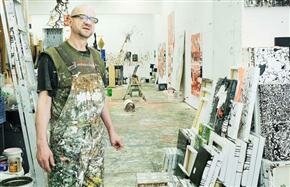Congratulations to Attila Richard Lukacs on his new exhibition at Windsor Gallery which opened May 12th and runs through to June 11.

Attila Richard Lukacs, the bad-boy of Canadian painting, talks about his exhibition at Winsor Gallery, his first solo show in a private gallery in Vancouver in years. Photographed by: Wayne Leidenfrost, PNG
Friday, May 13, 2011
By Kevin Griffin, Vancouver Sun
VANCOUVER — Attila Richard Lukacs is back with a new exhibition at the Winsor Gallery that’s unlike anything he’s done before.
What’s different about most of the works filling both levels of the South Granville gallery is that they’re big, bold abstract paintings. As anyone who has followed Lukacs’ career will know, that’s a big departure for an artist who has established a national and international name for himself with a dramatic series of paintings of Berlin skinheads in the late 1980s and 1990s.
Lukacs admitted that people who expect to see more figurative paintings may be disappointed. But he said that as an artist, he has to follow his own path and constantly challenge and renew himself.
“I know people would expect to walk into a figurative show. I’m sure somebody will walk into the gallery and double check — is this the right one? Maybe it’s next door,” he said in an interview in his east Vancouver studio.
Essay by
 Attila Richard Lukacs has been painting for about thirty years. Because he is mainly known for figurative work and has invested a great deal in positioning himself as a history painter, the current abstract paintings will surprise some. But abstraction has always been part of a practice in which the artist periodically directs his attention to “the problem of nothing,” or the condition of painting after the end of painting.
Attila Richard Lukacs has been painting for about thirty years. Because he is mainly known for figurative work and has invested a great deal in positioning himself as a history painter, the current abstract paintings will surprise some. But abstraction has always been part of a practice in which the artist periodically directs his attention to “the problem of nothing,” or the condition of painting after the end of painting.
I wonder if it would not be helpful in thinking about the new abstract paintings to consider their genealogy in terms of photography, collage, video, sculpture, bricolage, index, performance and confessional. All these non-painterly practices have a contemporary life in that they are able to disclose to us something about our condition in a way that abstract painting perhaps cannot. They are also part of the activity in Lukacs’ studio. His attempt to resuscitate painting has deployed a skein of strategies. In the past he has projected videos on canvas, painted on surfboards, arranged paintings in magical formations, painted on both sides of translucent material, all in the interest of reanimating painting.
Lukacs usually works automatically, referentially and by accretion. His paintings are made by brushing, dripping, pouring and scraping. There are never preliminary drawings. Certain substances have fascinated him for a long time, but mainly bitumen. It would be too crude to give this material a
national/biographic spin; Alberta contains the world’s largest deposits of bitumen: Lukacs was born and raised in Calgary; his father is in the oil industry. Rather one might think of the refined industrial uses of bitumen, mainly for waterproofing housing and surfacing roads, in ancient and modern times, but also, as a poetic correspondence. Bitumen was used to make the first photograph. It is the original black in the black and white world inaugurated by photography. For a painter the viscosity of bitumen is an available, unavoidable bodily metaphor. It is something organic and dead and also something photographic. Something crude, something refined.













